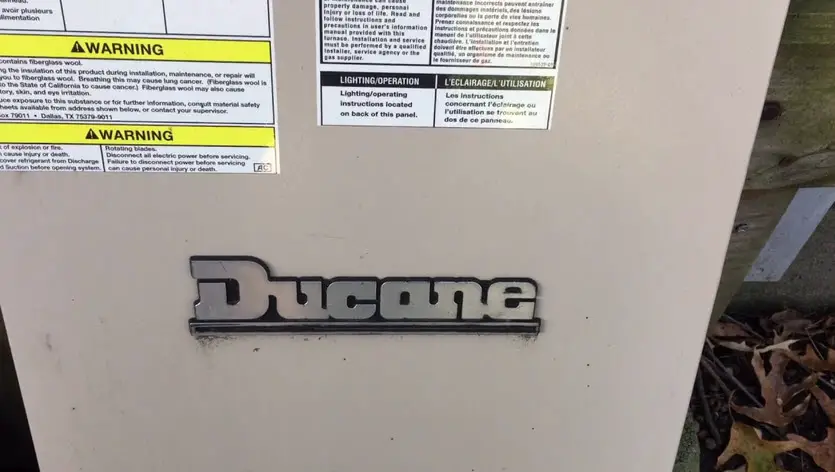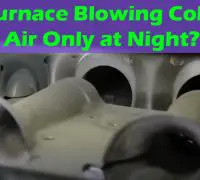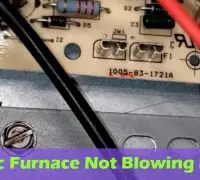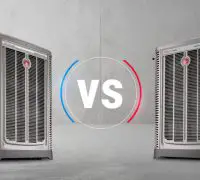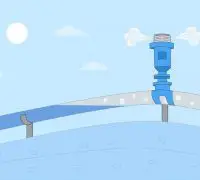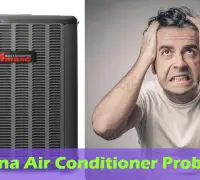The last thing you want in the winter is to have cold air coming out of the heat vents instead of a friendly and warm atmosphere. It’s never a good thing when your furnace blows cold air, and it’s cold outside and…inside. It’s not always a tragedy, and you don’t ever need to call the HVAC technician for repairs; sometimes, the reasons for which your furnace blows cold air have easy fixes. You only need to be meticulous and to eliminate, one by one, the most common causes for which your furnace blows cold air.
It doesn’t mean that something serious could make your furnace blow cold and not hot air, but if you’ve addressed all the possible reasons and still haven’t fixed it, you should call the HVAC professionals for further investigation.
Page Table of Contents
What are the common reasons for your Ducane furnace blowing cold air?
Furnaces are complicated machines that have sophisticated mechanisms for accurate and reliable performance. The risk for issues is never null when it comes to gas furnaces, but not all problems are severe. Keep reading to find out what could make your Ducane furnace blow cold air.
Wrong setting for the thermostat
When the thermostat isn’t set correctly, you may observe that the furnace blows cold air right from the heat registers. The air conditioner may run outside, and the temperature is lower than the set temperature reading on the thermostat.
Thermostats come in a great variety of models, but they all work for monitoring heating and cooling. Some models are programmable so that you may plan the temperature throughout the day, according to your schedule (when you’re at home, work, sleeping, etc.). Wi-Fi models will let you modify the settings from a mobile device or computer where you can access the internet. Therefore, the number of reasons for which the thermostat setting is incorrect is high.
What’s the fix?
If you suspect the thermostat, the first thing to do is take a look at the thermostat and identify the cause. Is it set for air conditioning and not on heating the air? If so, you need to re-set the thermostat for heating or modify the setting to auto, so the thermostat automatically switches from heating and cooling as temperatures change.
Is the fan running continuously, even if the furnace doesn’t heat the air? If so, the system could circulate cooler air throughout the heating cycles. You have to switch the fan to auto to turn off the blower when the furnace isn’t heating air.
Sometimes, it’s even something funny as somebody else set the temperature to a lower setting. If none of these tips works, it means something more severe if affecting the system, so you have to address it.
The pilot light is out.
If so, the furnace blows cold air, and you have no heat in the house.
Even if your furnace runs correctly if the pilot light is out, it won’t give hot air, but cold air. Back in the days, the pilot light was made to burn continuously, which increased the utility bills. Modern furnaces come with a pilotless ignition system (hot surface igniters), so it’s not typical for the pilot light to be the problem.
What’s the fix?
When the pilot light doesn’t light, you should examine if the primary valve is switched to the On position. You also have to look at the pilot H.S.I (Hot surface ignitor) to identify if it’s broken; ensure that nothing clogs the pilot orifice. The control valve could also be the cause for the pilot light not turning on.
You may try to relight the pilot, according to the manufacturer’s instructions. If the pilot doesn’t remain lit, you should call the professional.
The heater didn’t have time to warm up yet.
Should that be the case for your furnace, you will hear it kick on and not notice airflow; the blown air is, in fact, cold.
You may want to call the HVAC technician, but your furnace may not be operating incorrectly at all. It’s common for furnaces to come with a fan limit switch with a “blower on delay” function (A80UH2V & 80G2UH-V). The process lets the furnace warm up the air before the blower begins to push it out through the ductwork into the household. The short delay is supposed to increase comfort, eliminating the cold air from the heat vents.
What’s the fix?
You have to examine the owner’s information to determine if there is a blower delay after the burner starts. If the furnace still blows cold air after a couple of minutes, you need to contact the HVAC technician.
The fan limit switch didn’t work correctly.
When your furnace blows cold air or doesn’t run at all, the fan limit switch didn’t work correctly. Error message on the thermostat or blinking LED light on the control board (Code 3 flashes or Code 4 Flashes).
The fan limit switch will measure the air temperature inside the furnace/hot air supply plenum, controlling the blower motor functioning. As the furnace begins to heat, the fan limit switch will wait until the air gets to the set temperature before switching on the fan to blow hot air into the house. Once the healing process is over, it will wait until the internal air temperature goes below the set level, shutting down the fan until the heating cycle begins again. In case the limit switch doesn’t operate properly, the blower could run even when the furnace isn’t heating the air, which leads to cold air coming out from the registers. Also, the furnace could stop running altogether.
What’s the fix?
You should check the filter and clean/replace it accordingly. A dirty filter blocks airflow, so the heat exchanger overheats so that the fan limit switch may turn off the furnace. Sometimes, the overheating will damage the components, such as the heat exchanger.
Should the cleaning/replacement of the filter doesn’t solve the problem, you will have to call the professionals.
The flame sensor doesn’t run correctly.
When the temperature is more relaxed than the set temperature, or you hear the furnace running and stopping repeatedly, a flame sensor could be the culprit. If so, an error message on the thermostat or flashing LED light on the control board will inform you (CODE 1 flash or CODE 8 flashes).
The flame sensor has to identify the flame from the burner. When it’s running correctly, it will turn the furnace down when it’s not sensing a flame and the gas valve is running. The feature will stop natural gas/propane from going into the home’s air supply. When the flame sensor isn’t correctly running, it will turn off the furnace if the burner still runs as it doesn’t identify the heat.
What’s the fix?
If you’re able to see the burner in the furnace, you may also be capable of examining the flame sensor. Cracks in the porcelain base, soot build up on the tip could cause the problem.
It’s not difficult to clean the flame sensor, but you have to be very careful and follow specific steps when cleaning. Ask the technician if replacing the flame sensor is the solution. Sometimes, it’s safer to ask the professional to see if the flame sensor is causing the furnace to blow cold air.
The filter is dirty and overheats the furnace.
When the air is cooler than expected, or the airflow is weaker than regular, a dirty filter could be the cause. The dirty filter is also the culprit for the furnace’s short cycling (it turns on and off repeatedly).
No matter which type of filter the furnace has, you should always take good care of it and maintain it. Proper maintenance keeps the filter properly running. Improper maintenance will make dirt, dust, and various airborne pollutants clog the filter, block airflow, and cause discomfort. Sometimes, the furnace may fail.
What’s the fix?
Before examining the furnace filter, you have to take a look at the thermostat to see if it’s set to heating; make sure that the temperature setting is the one you want as well. Should you still think that a dirty air filter causes the problem, you need to read the owner’s manual for instructions about removing, cleaning, and replacing the filter.
Simple filters are placed inside the furnace cabinet, whereas large (4-inch) media filters, whole-home air purifiers, and electronic models are installed outside your furnace, right between the return air duct and the cabinet. If you’ve cleaned or replaced the air filter and the problem isn’t solved, you will have to call the professional for investigation.
Several supply vents are closed.
If the temperature is inconsistent in various rooms or some rooms are colder than others, or if the furnace goes through short cycles, several vents could be closed. Closed vents could also determine the temperature in the house not match the set temperature.
It’s common for homeowners to close the heat vents in rooms that aren’t used in the cold season; it’s a trick used to force hot air to go into specific rooms and save some of the energy. But the furnace is designed to provide comfort in the whole house, so closing too many vents will make the furnace modify the cycling, going on and off repeatedly. The temperature isn’t comfortable anymore, and the furnace may last for fewer years than expected.
What’s the fix?
You will have to open all the heat vents and notice if everything goes back to normal. If it does, but you still wish to close some vents, you should close fewer vents now. When opening the vents doesn’t fix the problem, you will need to call the professional as some ductwork, or the furnace could be the problem.
Air ducts leak warm air.
If the blown air is cold and the utility bills are continually increasing, whereas hot air comes out from the joints or seals in the ductwork, you should investigate a problem with the air ducts.
The age, quality, and condition of the household count a lot for the ductwork’s current state. Leaky ductwork reduces comfort and increases the utility bills as impressive amounts of heat are lost because of the leakage.
What’s the fix?
It’s not difficult to examine exposed ductwork in the basement or crawlspace. It would help if you turned on the furnace, keeping a hand over the connections, joints, and other areas where the ductwork’s sealing is visible. You can address the problem by straightening sheet metal and securing sheet metal joints with some screws. You may also use a properly rated tape or sealant. When duct leakage isn’t solved, and the furnace still blows cold air, you should call the professionals for a complete investigation. Some ducts won’t be effortless to seal, as they’re in difficult to reach areas.
